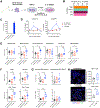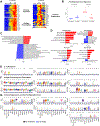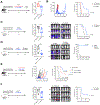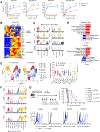Genetically engineered myeloid cells rebalance the core immune suppression program in metastasis
- PMID: 33765443
- PMCID: PMC8344805
- DOI: 10.1016/j.cell.2021.02.048
Genetically engineered myeloid cells rebalance the core immune suppression program in metastasis
Abstract
Metastasis is the leading cause of cancer-related deaths, and greater knowledge of the metastatic microenvironment is necessary to effectively target this process. Microenvironmental changes occur at distant sites prior to clinically detectable metastatic disease; however, the key niche regulatory signals during metastatic progression remain poorly characterized. Here, we identify a core immune suppression gene signature in pre-metastatic niche formation that is expressed predominantly by myeloid cells. We target this immune suppression program by utilizing genetically engineered myeloid cells (GEMys) to deliver IL-12 to modulate the metastatic microenvironment. Our data demonstrate that IL12-GEMy treatment reverses immune suppression in the pre-metastatic niche by activating antigen presentation and T cell activation, resulting in reduced metastatic and primary tumor burden and improved survival of tumor-bearing mice. We demonstrate that IL12-GEMys can functionally modulate the core program of immune suppression in the pre-metastatic niche to successfully rebalance the dysregulated metastatic microenvironment in cancer.
Keywords: T cells; cancer immunology; genetically engineered myeloid cells; immune suppression; immunotherapy; interleukin 12; metastasis tumor microenvironment; pre-metastatic niche; stem cell niche.
Published by Elsevier Inc.
Conflict of interest statement
Declaration of interests S.K., D.W.B., H.Q., and R.N.K. are inventors on international patent application no. PCT/US2020/17515, “Genetically modified hematopoietic stem and progenitor cells (HSPCs) and mesenchymal cells as a platform to reduce or prevent metastasis, treat autoimmune and inflammatory disorders, and rebalance the immune milieu and dysregulated niches.” The remaining authors have no competing interests. Inclusion and diversity One or more of the authors of this paper self-identifies as an underrepresented ethnic minority in science. One or more of the authors of this paper received support from a program designed to increase minority representation in science. One or more of the authors of this paper self-identifies as living with a disability. One or more of the authors of this paper self-identifies as a member of the LGBTQ+ community.
Figures







Comment in
-
A GEMy of a strategy to reverse immune suppression.Nat Rev Cancer. 2021 Jun;21(6):343. doi: 10.1038/s41568-021-00364-y. Nat Rev Cancer. 2021. PMID: 33893452 No abstract available.
-
GEMys homing in on metastasis.Nat Cancer. 2021 Dec;2(12):1284. doi: 10.1038/s43018-021-00288-4. Nat Cancer. 2021. PMID: 35121904 No abstract available.
References
-
- ALBRENGUES J, SHIELDS MA, NG D, PARK CG, AMBRICO A, POINDEXTER ME, UPADHYAY P, UYEMINAMI DL, POMMIER A, KUTTNER V, BRUZAS E, MAIORINO L, BAUTISTA C, CARMONA EM, GIMOTTY PA, FEARON DT, CHANG K, LYONS SK, PINKERTON KE, TROTMAN LC, GOLDBERG MS, YEH JT & EGEBLAD M 2018. Neutrophil extracellular traps produced during inflammation awaken dormant cancer cells in mice. Science, 361. - PMC - PubMed
-
- BONAPACE L, COISSIEUX MM, WYCKOFF J, MERTZ KD, VARGA Z, JUNT T & BENTIRES-ALJ M 2014. Cessation of CCL2 inhibition accelerates breast cancer metastasis by promoting angiogenesis. Nature, 515, 130–3. - PubMed
-
- BREMPELIS KJ, COWAN CM, KREUSER SA, LABADIE KP, PRIESKORN BM, LIEBERMAN NAP, ENE CI, MOYES KW, CHINN H, DEGOLIER KR, MATSUMOTO LR, DANIEL SK, YOKOYAMA JK, DAVIS AD, HOGLUND VJ, SMYTHE KS, BALCAITIS SD, JENSEN MC, ELLENBOGEN RG, CAMPBELL JS, PIERCE RH, HOLLAND EC, PILLARISETTY VG & CRANE CA 2020. Genetically engineered macrophages persist in solid tumors and locally deliver therapeutic proteins to activate immune responses. J Immunother Cancer, 8. - PMC - PubMed
Publication types
MeSH terms
Substances
Grants and funding
LinkOut - more resources
Full Text Sources
Other Literature Sources
Molecular Biology Databases

